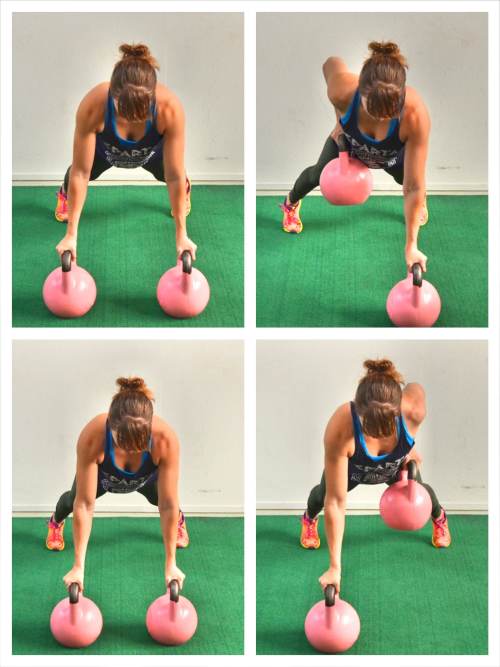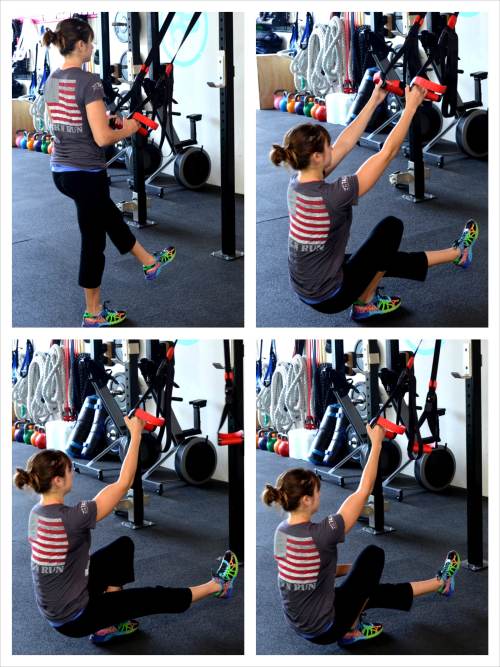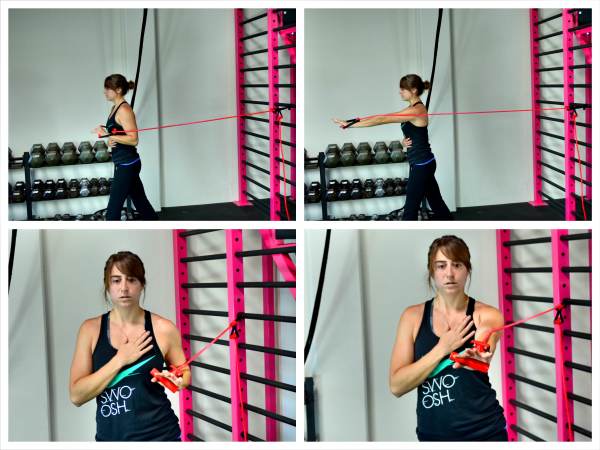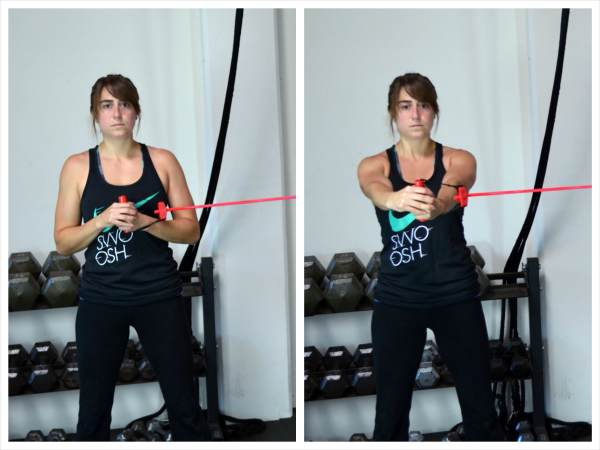WARM UP
Stretch and Roll Out:
Calves
Hamstrings
Quads/Groin
Hips/Glutes
Back/Chest/Shoulders/Traps
WORKOUT
Complete 3-5 rounds of each circuit. Rest as needed. Do not rush the movements but take your time to really use your core to stabilize.
CIRCUIT #1:
8-12 reps Unilaterally-Loaded Deadlift
8-12 reps per side Anti-Rotational Single-Arm Inverted Row
6-12 reps per side Renegade Rows
CIRCUIT #2:
8-12 reps per side Single Leg Squat
8-12 reps per side Anti-Rotational Single-Arm Press
8-12 reps per side Stability Press
COOL DOWN
Stretch and Roll Out:
Calves
Hamstrings
Quads/Groin
Hips/Glutes
Back/Chest/Shoulders/Traps
NOTES:
Do not rush through these movements. Take your time to really focus on core stability. Record reps, weights and variations so you can improve upon them over time!
EXERCISE DESCRIPTIONS:
Unilaterally-Loaded Deadlift – To do the Unilaterally-Loaded Deadlift, you can hold a dumbbell, kettlebell or even a sandbag. Hold the weight in one hand and hold it at your side like a briefcase. With the weight by your side, stand nice and tall with your feet about hip-width to shoulder-width apart. Then, hinge over at the hips as you sit your butt back and lean forward. Bend your knees as you hinge and lower the weight down to the ground. Keep your chest pressed out and your back flat as you hinge over. Drop the sandbag to the ground without allowing your body to rotate or lean. Hinge straight back and don’t shift to one side. Your Deadlift should look like you are holding weights in both hands. Really sit your butt back as you hinge and keep the abs engaged. Then drive straight back up to standing and squeeze your glutes at the top. Repeat, holding the weight on the same side. Again, do not let your back round as you lower down or let yourself lean or rotate. Once you’ve completed all reps on one side, switch the weight to the other hand. Start light so you can get proper form and make sure that you don’t shift or rotate. You should really feel your core working to keep your body in alignment.

Anti-Rotational Single-Arm Inverted Row – To do the Anti-Rotational Single-Arm Inverted Row, a Suspension Trainer works best. Grab one handle of the trainer in one hand and place the other hand across your chest. You can also reach the free arm up as if holding a strap if that will help remind you to keep your shoulders square. Set up with your body in a nice straight line, squeezing your quads, glutes and core and pressing your chest out. Make sure to relax your shoulder down and back and not shrug up. Walk your feet forward to an appropriate incline. The closer to parallel you are to the ground, the harder the move will be. Make sure that you choose an incline that allows you to row with proper form and feel your back working. You do not want your shoulder to shrug. Square up your body and then row up. Do not let the side not holding the strap rotate toward the strap as you row up or the shoulder of the arm not holding a strap to drop open. You want to row up as if you are pulling with both arms. That means your body shouldn’t close toward the strap or your shoulder shouldn’t open toward the ground. Drive your elbow down and back as you row up and row your chest all the way up to the handle. Do not shrug your shoulder as you row. Then lower back down. Do not let your back round or your body open up toward the ground as you lower. Repeat rowing back up, making sure that you don’t bounce off the bottom or rotate as you repeat.

Renegade Rows – To do the Renegade Row, you will need two weights. Set them on the ground under your shoulders. If you place your hands and the weights closer together, it will make the movement easier and help you balance. Then set up in a high plank position with each hand on a weight. Beginners may need to do this from their knees while more advanced exercisers will do this on their toes. If you are doing this on your toes, set your feet between hip-width and shoulder-width apart. You can also widen out your knees if doing this from your knees. A wider stance will make the move easier by providing you with a more stable base. In the plank position, engage your core and squeeze your glutes so that your body is in a nice straight line. Then row one weight up toward your chest, driving your elbow down and back. You want to drive it back toward the ceiling, but also down toward your hip. As you row up, fight your body’s urge to rotate. Keep your hips and chest square to the ground. Row the weight all the way up to your chest just below your pec. Keep your core tight and squeeze your glutes. Do not let your butt go up toward the ceiling or your hips sag. After rowing the weight up to your chest, lower the weight back down and then row up on the other side. Keep alternating until all reps are complete. Keep your core braced and fight the rotation as you alternate rows. Do not rush the movement.

Single Leg Squat – To do the Single Leg Squat to bench, choose a bench that is as low as possible. The lower the bench, the harder the move. Stand in front of the bench and lift one leg out in front of you. Then sit back and squat to the bench. The more you completely sit and reset on the bench, the easier the move will be, especially if you lift your standing leg and then stomp it back into the ground. If you just barely touch and go, you may find that the move is harder. Also, the more you swing your arms, the more momentum you will have to help you stand back up. Make sure to keep the heel of the standing leg down as you squat and drive back up to standing.

Another great Single Leg Squat variation to do if you need a little assistance is the Suspension Trainer Single Leg Squat.

Anti-Rotational Single-Arm Press – To do the Standing Anti-Rotational Single-Arm Press with a resistance band, anchor the band behind you at about chest height. Hold one handle in one hand and step away from the anchor point so that there is tension in the band when your hand is in at your chest. You can stand in a staggered stance or with both feet even. Standing with your feet even will make the move more challenging and force your core to work harder to stabilize. If you stand with your feet even, the wider apart your feet are, the more stable your base will be. To challenge your core further, stand with your feet even and close together. Then with your hand up at your chest and your shoulder relaxed down and back, press your arm straight out from your chest. Do not rotate as you press and do not let the shoulder shrug or the hand press up and out. You want to press straight out from the chest, keeping your chest pressed out and your shoulders down. Then once you press all the way out without letting your core rotate, bring the hand back. You want your body to move as if you were pressing both hands, aka with your chest and hips staying square instead of rotating. Complete all reps on one side before switching. You can place the hand that isn’t working across your chest, by your side or on your hip. Do whichever helps you fight the urge to rotate.

Stability Press – To do the Stability Press, you can use a resistance band or cable. If you are using a band, anchor the band and then hold one handle in both hands. Turn to the side so you are sideways to the anchor point and step away from the anchor point so that there is tension in the band. You want to make sure there is tension or the move won’t be challenging. Stand with your feet no more than shoulder-width apart. The closer your feet are together, the harder the move will be. Choose a stance though that challenges you while allowing you to maintain good form and not lean away. As you become stronger, bring your feet closer together and then even try a heavier band or walk further from the anchor point. Bring your hands into the center of your chest and squeeze your glutes while you brace your abs. Standing up nice and tall with your chest pressed out, slowly push the band straight out from the center of your chest until your arms are straight out. It should be a struggle to press the arms straight out because the band is trying to rotate you back toward the anchor point. Your core should have to work to stabilize and press straight out from your chest. Do not let your arms rotate open and go back toward the anchor. You want to press straight out from the center of your chest without shrugging your shoulders. Maintain a nice tall posture with your shoulder blades drawn down and back and your core engaged. Make sure you also don’t lean away. Then slowly bring your arms back in and repeat. Move slowly to really have to fight the band. If you move too quickly, you won’t get as much out of the move and you’ll probably get sloppy and let yourself rotate toward the anchor point or even shift open and push away. Also, if you allow your stance to rotate open or if you lean away, it will make the movement easier and won’t force that inside side (the side closest to the anchor point) to really work to stabilize. Complete all reps on one side before turning and facing the other way to work the other side. Really consciously engage your glutes before starting to press.

